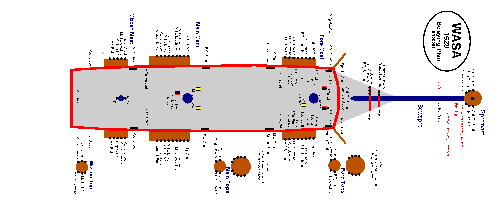Data
| Type/Class:
|
Dimensions:
|
Decks:
|
Armament:
|
Rigging:
|
Crew:
|
| Swedish Royal Ship
|
Total Length: 69m
Width: 11m
Height: 52m
|
Stepped Deck
5 decks, 2 gun decks
|
64 guns on 2 decks
|
3 masted full rigger
3-3-2 yards (fore-main-mizzen)
|
145 sailors, 300 soldiers
|
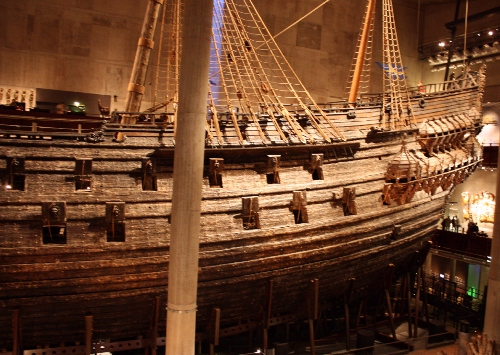
The Wasa today in the Vasamuseet, Stockholm
|
We could say that this is ship re-modelling - in 1:1 scale, reusing original parts :)
History
1626-28: Built in Stockholm.
1628: She sunk on her maiden voyage shortly after leaving the harbor, after just one nautical mile! This is what made her so famous ...
Later investigations showed that "she was well built as any other ship of her time, but she was ill proportioned".
The Swedish king (who could not be blamed, of course) wanted 2 gun decks instead of one, which lifted her gravity center so she was "top-heavy".
The open gun ports let in water when a squall blew into her topsails, and the loose ballast
moved to port ... the ship sunk soon,
and about 50 people were perished.
The flagg tops were still above the water, and some of her equippment was salvaged.
Then the ship was forgotten for about 300 years ...
1956: Anders Franzén rediscovered the Wasa.
1959-61: The Wasa was salvaged and stored in a special dock for preservation works. Those continued over a decade ...
1987: Ship opened to the public in the Vasamuseet in Stockholm. The Wasa is the oldest sailing warship preserved in the world.
|
Sources for Research
A good introduction is the Wikipedia article:
http://en.wikipedia.org/wiki/Vasa_(ship)
The reconstruction of the Wasa concentrated of course on the hull, because it had survived astonishingly well.
From her rigging, some parts could be salvaged, including some rope fragments and 2 sails (presumably the spritsail and a topgallant) that were still stowed under deck.
What her rigging really looked like will never be known for sure,
but the reconstruction of her rigging can still be preformed by using
other contemporary ships and their depictions as a pattern. Many attempts had been made, many solutions are possible.
The modern reconstructions shows the following, typical shape of a Royal Ship of the 17th century:
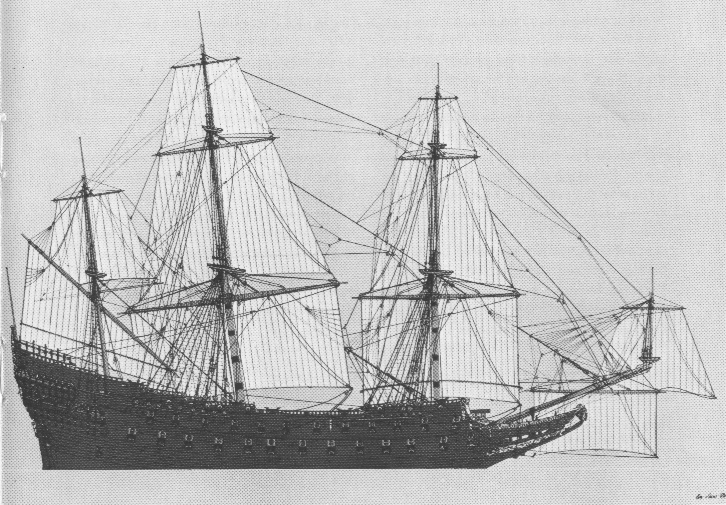
This reconstruction was made by the Swedish marine historian and Wasa curator Eva-Marie Stolt. As there are no contemporary images of the Wasa
(there were no maritime artists in Sweden in that era), research was done on which "prototype" the Wasa had been built upon.
The conclusion was that the shipbuilder, Arent Hybertsson, used a Dutch coppar engraving of the French Royal Ship "Le Saint Louis",
alias "Navire Royale" (French, which can be translated as "Royal Ship" - without a name or "The Ship 'Royale'");
that ship was built in the Netherlands for the French Navy. The engraving was reused many times in many
contemporary publications as a pattern how a royal ship looked like or should look like in general:
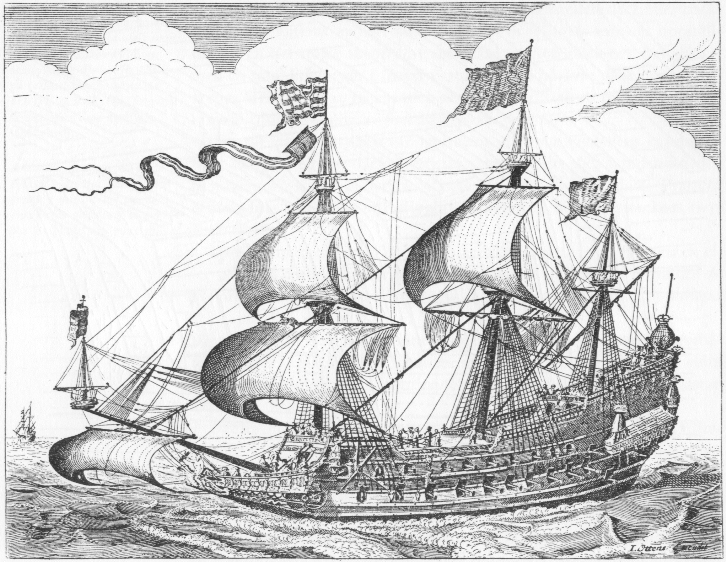
The rigging on this image was eventually the pattern for the reconstruction of the Wasa.
Books
| TITLE | AUTHOR | PUBLISHER | YEAR | PAGES |
En bok om skeppet Wasa
(Swedish) |
Hafström, Georg |
Christofers Bokförlag |
1959 |
202 |
Med Vasa på Strömmens botten
(Swedish) |
Fålting, Per Edvin |
Gebers AWE |
1961 |
116 |
Regalskeppet Vasan från början till slutet
(Swedish) |
Landström, Björn |
Rahm & Stenström Interpublishing |
1980 |
158 |
Skulpturer (Regalskeppet Wasa)
(Swedish) |
Soop, Hans |
LiberFörlag |
1978 |
152 |
The Swedish Warship WASA
(English) |
Ohrelius+Kvarning |
The Macmillan Press |
1973 |
36 |
The Wasa her place in history
(English) |
Naish, George P.B. |
National Maritime Museum |
1968 |
24 |
Utblickar kring tillkomsten av skeppet WASA
(Swedish) |
Hafström, Georg |
Statens sjöhistoriska museum |
1968 |
150 |
Varför kantrade Vasa ?
Vasastudier 12 (Swedish) |
Borgenstam, C + Sandström, A |
Vasamuseet, Stockholm |
1984/1995 |
80 |
Vasa - Regalskeppet i ord och bild
(Swedish) |
Franzén, Anders |
Norstedts/Bonniers |
1966 |
88 |
Vasa, kungens skepp
(Swedish) |
Ohrelius, Bengt |
Rabén & Sjögren |
1959 |
96 |
Wasa fynd och bärgning
(Swedish) |
Clason+Franzén |
Norstedts/Bonniers |
1959 |
64 |
Wasa, kungens skepp
(Swedish) |
Ohrelius+Kvarning |
LiberFörlag |
1978 |
183 |
Wasa, kungens skepp
(Swedish) |
Ohrelius+Kvarning |
Rabén & Sjögren |
1972 |
174 |
Äventyret Vasa
(Swedish) |
Widding, Lars |
Gebers AWE |
1961 |
202 |
You may want to consult this excellent book list, too: http://www.bruzelius.info/Nautica/Bibliography/Wasa.html
Reconstructions
The Rigging
|
The Wasa has a typical full rigging of the 17th century:
3 yards at fore and main mast
1 lateen sail and a topsail on the mizzen mast
1 yard at the bowsprit.
|
The Standing Rigging
|
|
Bowsprit - Fore Mast
|
Fore Mast - Main Mast
|
Main Mast - Mizzen Mast
|
Mizzen Mast
|
Topgallant Mast
|
|
- single stay
- 1 backstay
- 2 shrouds
|
- single stay
- 1 backstay
- 2 shrouds
|
- single stay
- 1 backstay
- 2 shrouds
|
Topmast
|
|
- single stay
- 1 backstay
- 5 shrouds
|
- single stay
- 1 backstay
- 5 shrouds
|
- single stay
- 1 backstay
- 4 shrouds
|
Lower Mast
|
- 3 guys (over spritsail yard)
- martingale guys (dolphin striker)
- 3 water stays
- 2 bowsprit shrouds
|
- double stay
- 8 shrouds
- 1 truss (lower yard)
|
- double stay
- 9 shrouds
- 1 truss (lower yard)
|
- single stay
- staysail stay
- 5 shrouds
- 1 truss (lateen yard)
|
The Running Rigging
|
|
Bowsprit
|
Fore Mast
|
Main Mast
|
Mizzen Mast
|
Topgallant Sails
3rd yard
|
|
Fore Topgallant
- 1 Halyard
- 2 Topping Lifts
- 2 Sheets
- 2 Clewlines
- 2 Braces
|
Main Topgallant
- 1 Halyard
- 2 Topping Lifts
- 2 Sheets
- 2 Clewlines
- 2 Braces
|
Top Sails
2nd yard
|
Sprit Topsail
- 1 Halyards
- 2 Topping Lifts (p.+s.)
- 2 Sheets (p.+s.)
- 2 Clewlines (p.+s.)
- 2 Braces (p.+s.)
|
Fore Topsail
- 2 Halyards (p.+s.)
- 2 Topping Lifts (p.+s.)
- 2 Sheets (p.+s.)
- 2 Clewlines (p.+s.)
- 2 Leechlines (p.+s.)
- 2 Buntlines (p.+s.)
- 2 Bowlines (p.+s.)
- 2 Braces (p.+s.)
- 2 Reef Tackles (p.+s.)
|
Main Topsail
- 2 Halyards (p.+s.)
- 2 Topping Lifts (p.+s.)
- 2 Sheets (p.+s.)
- 2 Clewlines (p.+s.)
- 2 Leechlines (p.+s.)
- 2 Buntlines (p.+s.)
- 2 Bowlines (p.+s.)
- 2 Braces (p.+s.)
- 2 Reef Tackles (p.+s.)
|
Mizzen Topsail
- 1 Halyard (p.+s.)
- 2 Topping Lifts (p.+s.)
- 2 Sheets (p.+s.)
- 2 Clewlines (p.+s.)
- 2 Leechlines (p.+s.)
- 2 Buntlines (p.+s.)
- 2 Bowlines (p.+s.)
- 2 Braces (p.+s.)
|
Lower Sails / Courses
lower yard
|
Spritsail
- 1 Halyards
- 2 Topping Lifts (p.+s.)
- 2 Sheets (p.+s.)
- 2 Clewlines (p.+s.)
- 2 Buntlines (p.+s.)
- 2 Braces (p.+s.)
|
Fore Course
- (fixed in a rack)
- 2 Topping Lifts (p.+s.)
- 2 Sheets, 2 Tacks (p.+s.)
- 2 Clewlines (p.+s.)
- 2 Leechlines (p.+s.)
- 4 Buntlines (p.+s.)
- 2 Braces (p.+s.)
|
Main Course
- (fixed in a rack)
- 2 Topping Lifts (p.+s.)
- 2 Sheets, 2 Tacks (p.+s.)
- 2 Clewlines (p.+s.)
- 2 Leechlines (p.+s.)
- 4 Buntlines (p.+s.)
- 2 Braces (p.+s.)
|
Crossjack
yard only, no sail
1 sling
2 Topping Lifts (p.+s.)
2 Braces (p.+s.)
|
Stay Sails
Fore and Aft Sails
|
|
|
|
Lateen Sail
- 1 Halyard, 1 Peak Lift
- 2 Gaff Vangs
- 2 Sheets
- 4-6 Brails
|
These are the lines to be belayed ...
Belaying Positions
|
This is 100% speculation for the Wasa, even if we actually KNOW about her hull and deck layout!
NO original plans survived (it can be assumed that they never existed), and not even a contemporary artists´ picture that could tell anything about her rigging!
OK. Despite all this, here is my guess, based on the sail plan reconstruction by Stolt,
some plans for modern models of the ship, and the experience onboard the
Götheborg III replica in 2009:
Models of the WASA
The Wasa Museet in Stockholm itself has 2 splendid, giant models of the Wasa.
One shows even the most recent results of the colors used on her hull. In contrary to
earlier researches, the main color seems to have been red, not blue. And the figures were
in bright colors, too, not golden:
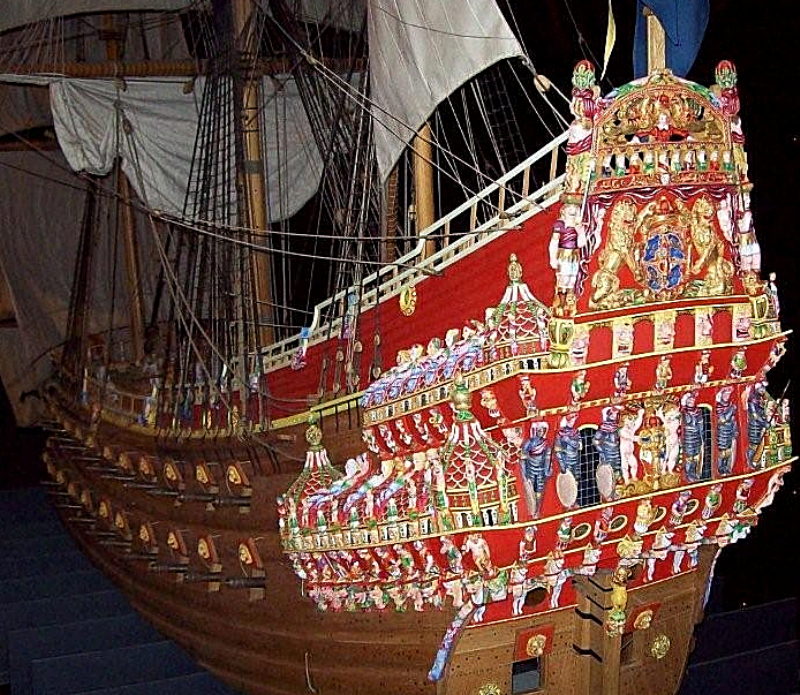
The Airfix model kit, Scale 1:144?
The Airfix kit of the Classic Ship series, the only known plastic kit of the Wasa. It is sold mostly in Sweden of course :)
My model is still in the making ...
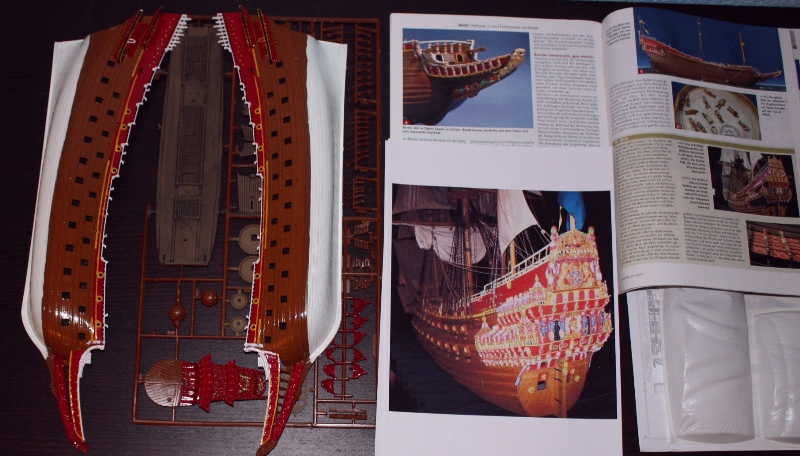
|
|



